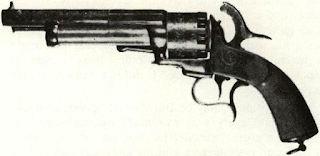Two partners in Memphis need to be mentioned here
While the author once made such a promulgation
Memphis Manufacture. We were yesterday shown by
It will be remembered that three weeks before (November 15) the Memphis Daily Appeal was making big
Henderson, Jr., Savannah, Ga.
guard is more ovaled, as if stretched a litde to fit over
These few arms were the total of revolvers produced
10 are mentioned, indicates the extremely low productivity of the South in this respect. Probably not over
That they were good guns, is attested by the surviving
Today, because of the demand, faking is common in
While the author once made such a promulgation
Memphis Manufacture. We were yesterday shown by
It will be remembered that three weeks before (November 15) the Memphis Daily Appeal was making big
Henderson, Jr., Savannah, Ga.
guard is more ovaled, as if stretched a litde to fit over
These few arms were the total of revolvers produced
10 are mentioned, indicates the extremely low productivity of the South in this respect. Probably not over
That they were good guns, is attested by the surviving
Today, because of the demand, faking is common in


Comments
Post a Comment